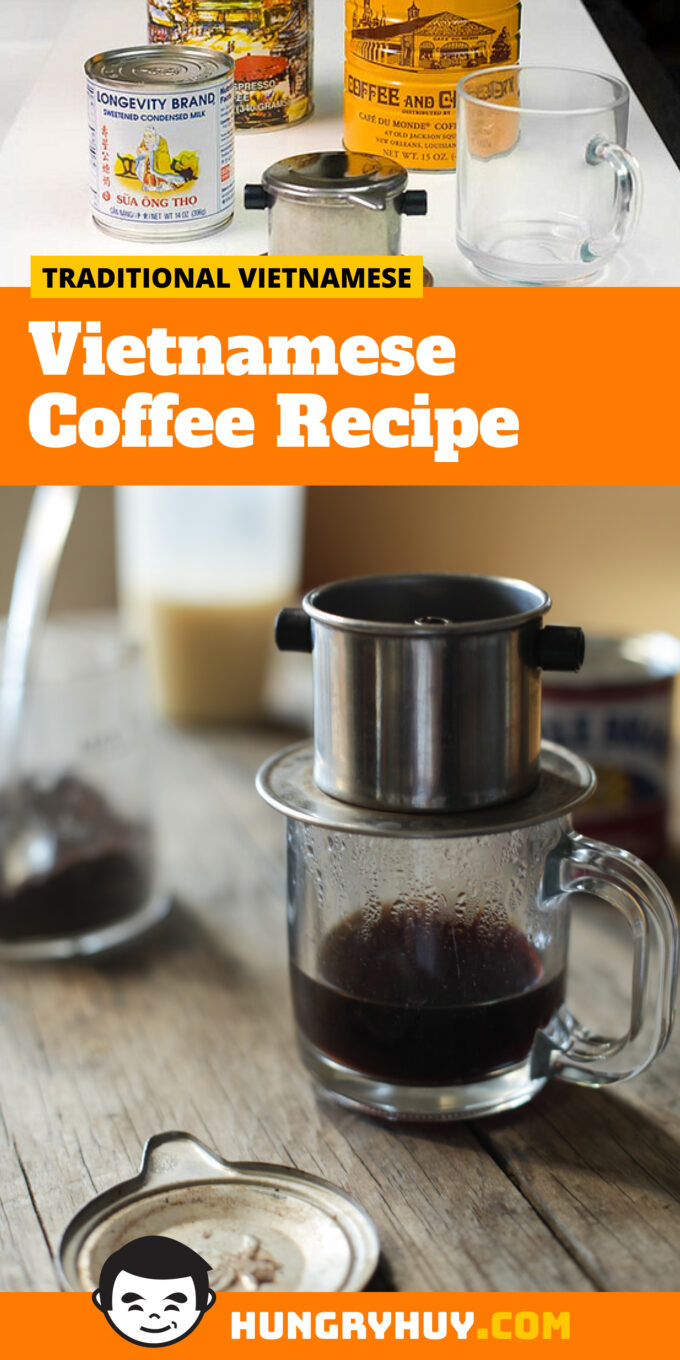Vietnamese coffee is an intensely strong and sweet coffee, that’s sure to dissolve your morning daze and perk you up for the day. Its dark roast coffee and potent condensed milk, slowly dripped through a metal filter (phin) make this a unique coffee.
In Vietnam, coffee, whether it’s brewed and served at home or in restaurants, is brewed leisurely (i.e. less intense than how I typically brew pour over coffee). Hot coffee (cafe nong) is preferred in the morning, while iced coffee (cà phê sữa đá) is saved for the heat later in the day.
How do you drink Vietnamese coffee you ask? Any way you’d drink any other coffee! I especially like to sip on this stuff after a big bowl of phở, or when snacking on buttery, piping hot pâté chaud, or crispy pandan waffles.
I was talking to my Dad about coffee and he was reminiscing about his many past cups. He’s completely happy here in the States, but has an incredibly fond memory of his life in Vietnam. “There was nothing like escaping from the rain-running into a coffee shop with a lightly damp raincoat. I can immensely enjoy a cup in that kind of atmosphere.”
Vietnamese coffee bean brands
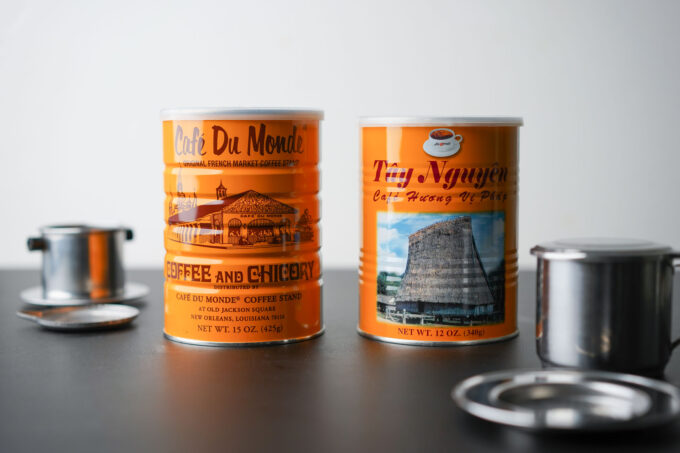
In America there are sooo many popular brands of Vietnamese coffee you can order and have shipped to your doorstep:
- Trung Nguyen – pre-ground
- Trung Nguyen – G7 instant coffee
- Vinacafe – instant coffee
- Chestbrew – Moon Bear whole bean
- Cafe Du Monde – pre-ground (the one I typically use)
- Lang Thang – Saigon Phin Daklak
These are just to name the popular ones available in America! Lately there are many new roasters in America trying to hop on the Vietnamese coffee scene. There seems to be a few small companies popping up every year starting as local roasters, selling at farmers markets, and eventually shipping their beans nationwide and worldwide.
We saw the big name coffee brands like Trung Nguyen above have chains of coffee shops when visiting Vietnam in 2020. In Vietnam there are countless other brands producing, roasting, and selling Vietnamese coffee and beans though that you simply cannot buy in America.
People are passionate about their coffee, and asking which brand or type of Vietnamese coffee is best is sure to stir up some arguments!
Click here to get Smart Blood Sugar at discounted price while it’s still available…
Vietnamese metal coffee filter or “phin”
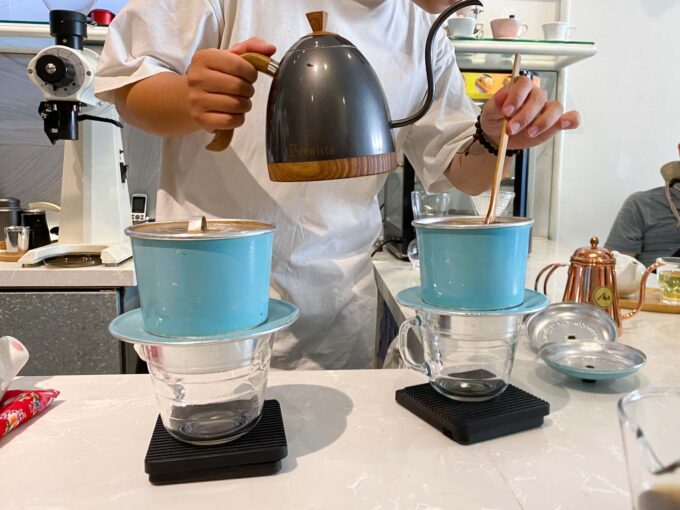
The Vietnamese coffee filter gives a stronger brew than that of an American drip machine and different than that of a French press, which has a lot of factors.
But the metal coffee filter used to brew Vietnamese coffee is a large part of it what makes Vietnamese coffee unique. The filter is sometimes referred to as a Vietnamese press, or Vietnamese dripper, but it’s all the same item, or the same phin.
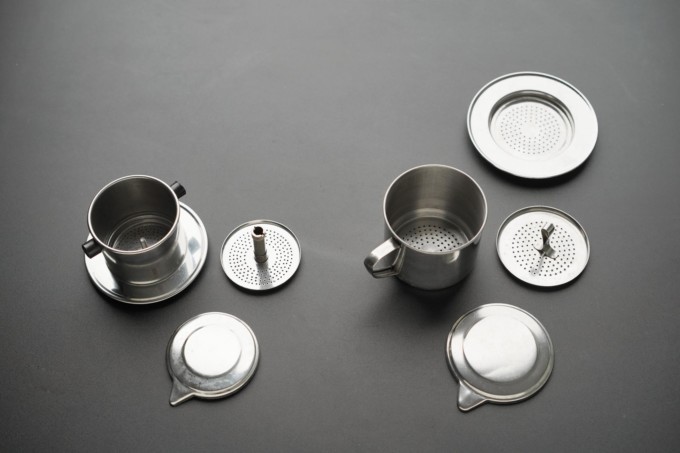
The “phin” (pronounced like feen), is typically made of three or four parts:
The lid – This helps keep the coffee from losing heat or evaporating too much while brewing.
The body – This is the main cylindrical center where the coffee grounds go. The
A filter disk – This goes into the body and sits on top of the coffee. On older versions of the phin I’ve seen, this can screw into a threaded shaft that’s part of the body. This added another variable to adjust while brewing-how tight this was screwed on.
However on most newer types I’ve seen this is a simple disk with a handle on top for removal that sits on top of the coffee grounds. This means the main way you control the speed and strength of brew is reduced to water temperature, water volume, coffee volume (and grind size if grinding your own.
The rim or lip – simply the rim around the filter so you can rest it on a glass while brewing.
The sweet condensed milk
Why is Vietnamese coffee so sweet you ask? The condensed milk!
Traditional Vietnamese coffee is very strong so the concentrated and very sweet condensed milk is a natural pairing for it. When you buy Viet coffee at stores, the default is SUPER SWEET.
When I make it myself, I like taking the sugar down by about 50% so more coffee flavor comes through, so feel free to sweeten it as you like! Condensed milk usually comes in cans, because its simple and cheap to produce.
The problem is that the milk is super thick and sticky so it’s not fun to have to transfer to another storage container. So, you can do like my dad does and just leave it open like that in the fridge with a spoon in it, or transfer it to a squeeze bottle.
I like using Longevity Brand as shown below, typically available at Vietnamese or Asian supermarkets. However, I’ve used Eagle Brand, and the Trader Joe’s store brand in a sqeeze bottle which is very convenient. And to be honest they taste very similar to me.
How was Vietnamese coffee invented?
Although we Vietnamese “owe” the availability of ingredients for this coffee to French colonization, this creation is Vietnamese. Vietnamese coffee is uniquely characterized by a combination of a dark roast coffee dripped through a metal Vietnamese coffee filter mixed with condensed milk.
More often than not, you’ll see this served with lots of crushed ice since it is so refreshing! You can order Vietnamese coffee hot too, but this seems to be much less popular in comparison, at least in America.
Vietnamese coffee varietals and filler?
Notice that Cafe Du Monde isn’t pure coffee! This grind is laced with the ground root of the chicory herb. This mixture originated in Europe during WWII when money was tight and expensive foods like coffee needed to last. Chicory root was used to stretch the coffee supply. After the war, the preference for the chicory flavor became a trend and exists even today.
The new companies have more modern marketing and branding campaigns, and source beans, often times from single family-owned farms in Vietnam for the typical Vietnamese coffee roast. The varietal commonly used for Vietnamese coffee is the robusta bean.
Where can you buy ready to drink Vietnamese coffee?
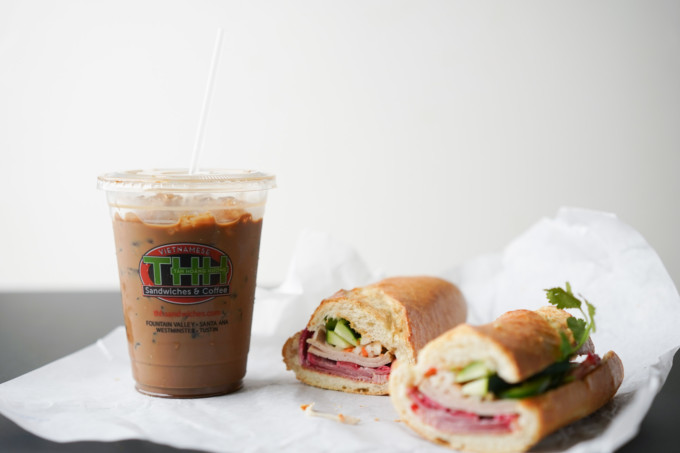
Vietnamese sandwich and coffee shops
I typically buy Vietnamese coffee at bánh mì shops, like our local chain Banh Mi Che Cali, or Tan Hoang Huong in Southern California.
Of course the mega-chain Lee’s Sandwiches sells Vietnamese coffee too, but we have beter sandwich options, and their coffee is way sweeter than I prefer. I think it’s premade so you can’t request the coffee to be made less sweet here, but it’s fine in a pinch.
Costco
Our local Costcos stock a concentrated version of Lee’s Vietnamese coffee in the freezer section too! Each 16 fl oz bottle of this concentrate is meant to be defrosted, then poured over lots of ice to make about 3-4 servings of Viet coffee. I must say it’s pretty similar to what you can buy at their store ready to drink! But a bit too sweet to me.
American coffee shops
Some third wave coffee shops have been trying to ride the wave of Vietnamese coffee popularity by offering their own takes on Vietnamese coffee. I get excited to see it and always give it a shot, but have been disappointed just about every time.
The quality ranges from decent, to outright bad. Most of these shops don’t even try to use Vietnamese coffee beans, and don’t use the intense condensed milk, but rather wing it to create a “close enough” concoction they can label as Vietnamese coffee-not cool.
We actually have ONE local, modern, Vietnamese-owned-but-American-looking coffee shop nearby that does a good job with Vietnamese coffee. This was a rare find. I think the core of why it’s traditionally on point is it’s more of a Vietnamese coffee shop that looks modern/American.
Starbucks probably has avoided marketing a drink called Vietnamese coffee for these reasons. They don’t normally stock right ingredients to do it right and it would create unnecessary items to stock for just a single drink.
However Starbucks fans have of course found a way to hack the menu and order a redition of it. This typically involves about 3 shots of espresso (sometimes blonde), 4-5 pumps of white mocha, either heavy cream or whipped cream and lots of ice.
How do you make Vietnamese coffee?
To brew Vietnamese coffee you need French roast coffee grounds, water, condensed milk, and a phin (a Vietnamese coffee filter). Boil the water and preheat the filter and cup by adding some water through. Remove excess water, then add a heaping tablespoon of coffee into the filter.
Twist the filter on top until there is some resistance and pour some water inside and wait for the grounds to expand before filling the filter all the way up. Brew for three to five minutes, then add the desired amount of condensed milk into the cup.
